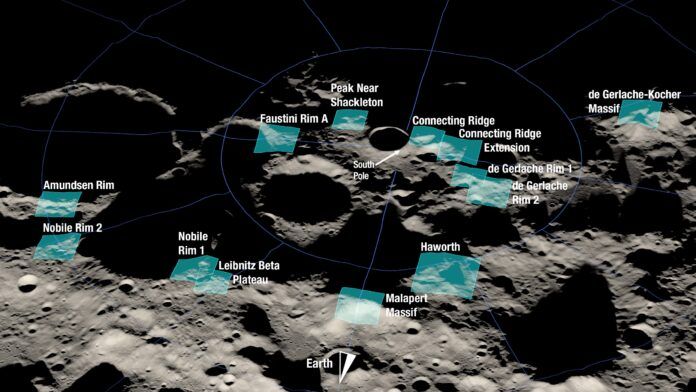NASA has identified 13 potential landing regions for Artemis III, which is expected to be the first crewed mission to land on the lunar surface since 1972. The regions measure approximately 15 by 15 kilometers (9.3 by 9.3 miles) and are all located within 6 degrees of latitude of the Moon’s South Pole. According to NASA, the sites were chosen based on factors including launch window availability, ability to accommodate a safe landing and likelihood of meeting specific Artemis III science objectives such as landing “close enough to a permanently shadowed region to allow crew to conduct a moonwalk.”
“Selecting these regions means we are one giant leap closer to returning humans to the Moon for the first time since Apollo,” said Mark Kirasich, NASA deputy associate administrator for the Artemis Campaign Development Division. “When we do, it will be unlike any mission that’s come before as astronauts venture into dark areas previously unexplored by humans and lay the groundwork for future long-term stays.”
The first Artemis mission, a 42-day uncrewed flight test of the Space Launch System (SLS) and the Orion spacecraft, is scheduled to launch as soon as Aug. 29, 2022. Artemis II, tentatively slated for mid-2024, will be the program’s first crewed flight test. NASA is currently looking to launch Artemis III in 2025.




































Our national debt is now nearly $31T. Why are we wasting more tax dollars to send men to the moon to look at more dust and rocks? If there was value in this, it could all be handled through private companies. Perhaps Bill Nye, the (fake) Science Guy, could sell tickets to visit his ancestral home. He believes we’re all descendants of Mars men.
I think “giant leap” has been used before… With a new program maybe NASA could coin a new expression?
NASA has never needed to validate their spending. That agency is one large barbecue pit that people pour money into without any sound reasoning other than to keep the fire burning!
Space X will be there years before NASA.
Note the fact that NASA’s supposed to launch this year. LOL
I would have hoped that the initial discussion on a landing would be “WHY” was there a need for manned missions to the moon rather than long-term robotic missions.
For those whose mindset is that any dollar not spent on welfare is a waste, thinking of it as welfare for science & knowledge may help.
Correct, Mr. John W..
Was under the impression that the next ldg would be to finding water – ha -but that was just a dream – eh?
No, that’s still a biggie. That’s what is behind the mention of selecting landing sites that would allow moonwalk access to permanently shaded areas, which are top candidates for water.
Just curious, why care about water on the moon?
Lets hope that with digital cameras, Lidar and all, the landing sites are not covered in large rocks, like Apollo 11.
More I read about the moon landing, the more I believe in luck, and Neil Armstrong’s reactions.